Fisher & Paykel BE1-48R, BE1-36R User Manual
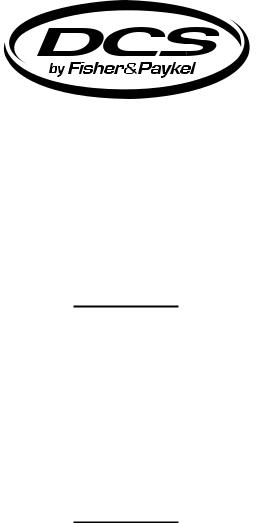
OUTDOOR GRILL
36 & 48" BE models
GRIL EXTÉRIEUR
Modèles 36 et 48" BE
INSTALLATION GUIDE / USER GUIDE GUIDE D’INSTALLATION / GUIDE D’UTILISATION
US CA

CONTENTS |
EN |
|
|
Safety and warnings |
3 |
Grill models |
6 |
Product dimensions |
7 |
Installation |
|
Locating grill / built-in clearances |
8 |
Built-in construction details |
13 |
Gas hook-up |
15 |
Leak testing |
18 |
Electrical connection |
19 |
Burner adjustment |
20 |
Radiant assembly |
21 |
Installer checklist |
22 |
Using the grill |
|
Lighting instructions |
24 |
Grilling |
25 |
Using the grates |
32 |
Using the charcoal insert |
33 |
Using the rotisserie |
34 |
Accessories |
39 |
Care & maintenance |
40 |
Troubleshooting |
44 |
Warranty and Service |
45 |
IMPORTANT!
SAVE THESE INSTRUCTIONS
The models shown in this user guide may not be available in all markets and are subject to change at any time. For current details about model and specification availability in your country, please visit our website listed on the back cover or contact your DCS by Fisher & Paykel dealer.
1
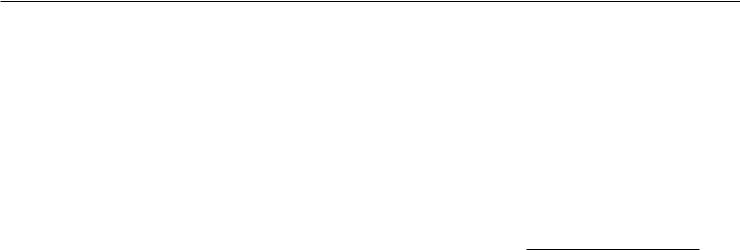
A MESSAGE TO OUR CUSTOMERS
Thank you for selecting this DCS Evolution Series Grill. This installation and user guide contains valuable information on how to properly install, operate and maintain your new appliance for years of safe and enjoyable cooking.
Please fill out and submit your Product Registration by visiting our website at www. dcsappliances.com and selecting “Support” on the home page and then selecting “Product Registration”. In addition, keep this guide handy, as it will help answer questions that may arise as you use your new appliance.
For your convenience, product questions can be answered by a DCS Customer Care Representative at www.dcsappliances.com, or email: customer.care@fisherpaykel.com.
Please write the model, code, and serial numbers on this page for reference (this can be found on the inside, right side panel behind the drip pan handle. See page 22.)
MODEL NUMBER |
|
CODE |
|
SERIAL NUMBER |
IMPORTANT!
DO NOT discard any packing material (box, pallet, straps) until the unit has been inspected. Inspect the product to verify that there is no shipping damage. If any damage is detected, call the shipper and initiate a damage claim. DCS by Fisher & Paykel is not responsible for shipping damage.
2
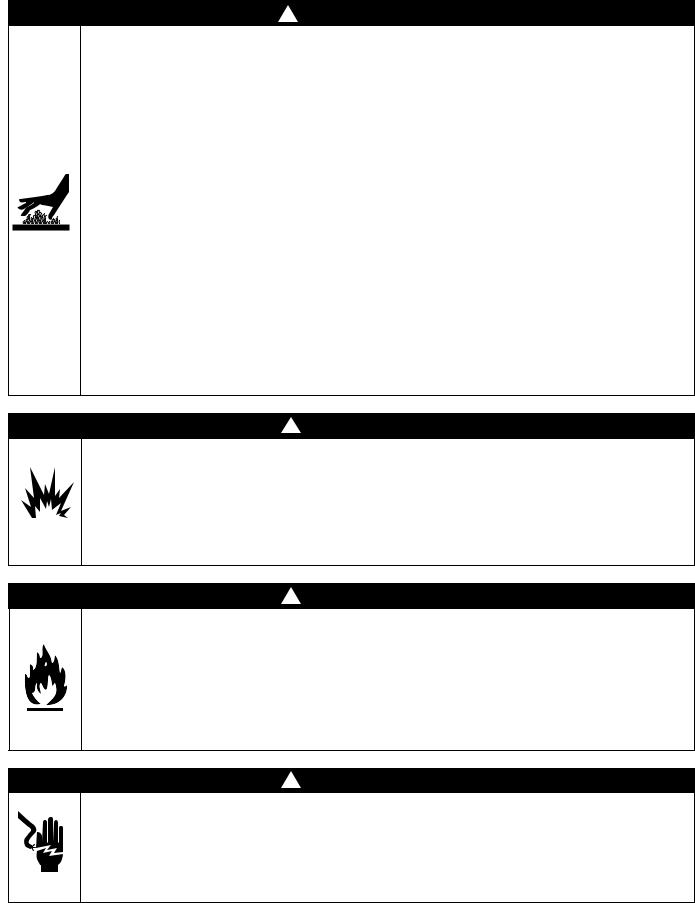
SAFETY AND WARNINGS |
EN |
|
|
To reduce the risk of fire, electrical shock, injury to persons, or damage when using the appliance, follow the important safety instructions listed below:
! WARNING!
Hot Surface Hazard
Accessible parts may become hot during use.
Do not touch surface units or areas near units of the grill. Hood must be opened before lighting the grill.
Never let clothing or other flammable materials come in contact with or get too close to any grate, burner or hot surface until it has cooled. Fabric may ignite and result in fire or personal injury.
Never lean over an open grill. When lighting a burner, always pay close attention to what you are doing. Be certain you are pushing the burner knob when you attempt to light the grill.
When using the grill, do not touch the grill burner, grate, or immediate surrounding area as these areas become extremely hot and could cause burns.
Grease is flammable. Never operate the grill without a grease tray. Let hot grease cool before attempting to handle it. Avoid letting grease deposits collect in the drip pan. Clean the grill with caution. Avoid steam burns; do not use a wet sponge or cloth to clean the grill while it is hot. Some cleaners produce noxious fumes or can ignite if applied to a hot surface.
Use only dry potholders; moist or damp potholders on hot surfaces may cause burns from steam. Do not use a towel or bulky cloth in place of potholders. Do not let potholders touch hot portions of the grill or burner grate.
To avoid burns when cooking, use long handled BBQ tools.
Failure to follow this advice may result in burns and scalds or serious injury.
! WARNING!
Explosion Hazard
If you smell gas, do not use the appliance.
Do not use water on grease fires, a violent steam explosion may result. Turn all burners off, then smother fire or flame or use dry chemical or foam-type extinguisher.
Do not heat unopened food containers such as cans – Build up of pressure may cause container to burst and result in injury.
Failure to follow this advice may result in injury or death.
! WARNING!
Fire Hazard
Do not operate the grill under unprotected combustible construction. Use only in well ventilated areas. Do not use in buildings, garages, sheds, breezeways, covered structures or other such enclosed areas. This unit is for outdoor use only.
Never leave the grill unattended when in use.
Never store a spare LP cylinder under or near this unit. Never fill the tank beyond ¾ full.
Failure to follow this advice may result in death or serious injury.
! WARNING!
Electrical Shock Hazard
This appliance is equipped with a three-prong or four-prong grounding plug for your protection against shock hazard and should be plugged directly into a properly
grounded power outlet. Do not under any circumstances cut or remove the grounding prong from this plug.
Failure to follow this advice may result in death or electrical shock.
3

SAFETY AND WARNINGS
IMPORTANT SAFETY INSTRUCTIONS!
yAfter a period of storage or non-use (such as over the winter), the gas grill should be checked for gas leaks, deterioration, proper assembly, and burner obstructions before using.
yAlways use a covered hand when opening the grill hood and only do so slowly to allow heat and steam to escape.
yAfter lighting burners, make sure burners are operating normally (see page 20).
yDo not use aluminium foil to line drip pans or grill grates or radiants. This can severely upset combustion air flow or trap excessive heat in the control area. The result of this can be melted knobs or damaged ignition components.
yDo not operate with a damaged cord or plug, after the appliance malfunctions or after the appliance has been damaged in any manner. Contact the manufacturer for repair.
yDo not let the rotisserie cord hang over the edge of a table or touch hot surfaces.
yDo not use an outdoor cooking appliance for purposes other than intended.
yDo not use lighter fluid in the charcoal burner insert or on the gas burners.
yBe sure all grill controls are turned off and the grill is cool before using any type of aerosol cleaner on or around the grill. The chemical that produces the spraying action could, in the presence of heat, ignite or cause metal parts to corrode.
yNever grill without the drip pan and grease tray in place and hooked into the front of the grease tray (see Fig. 34 on page 40 for diagram). Without it hot grease could leak downward and produce a fire or explosion hazard.
yIf you are using griddle plates, do not place them side by side on the grill or on top of the Infrared Hybrid Burner.
yNever use the grill in a windy area.
yDo not try lighting this appliance without reading the “LIGHTING INSTRUCTIONS” section of this manual.
yDo not locate, store or operate the grill on an inclined plane.
yKeep any electrical supply cord, or the rotisserie motor cord away from the heated areas of the grill and water (pools, fountains, puddles).
yNever use a dented or rusty LP tank. Keep the ventilation openings of the cylinder enclosure free and clear from debris.
yHave an ABC rated Fire Extinguisher accessible – never attempt to extinguish a grease fire with water or other liquids.
yDo not move the appliance during its use.
yDo not operate in enclosed areas. This could result in carbon monoxide build-up which would result in injury or death.
yWhen using a grill, be sure that all parts of the unit are firmly in place and that the grill is stable (can’t be tipped over).
yTo put out flare-ups, adjust the controls to lower the temperature
yDo not ignite the grill burners while the rotisserie burner is lit.
yNever attach or disconnect an LP cylinder, or move or alter gas fittings when the grill is in operation or is hot.
yCALIFORNIA PROPOSITION 65-WARNING: the burning of gas cooking fuel generates some by-products which are on the list of substances which are known by the State of California to cause cancer or reproductive harm. California law requires businesses to warn customers of potential exposure to such substances. To minimize exposure to these substances, always operate this unit according to the manual, ensuring you provide good ventilation when cooking with gas.
yThis outdoor cooking gas appliance is not intended to be installed in or on recreational vehicles, trailers and/or boats.
yThis product must be installed by a licensed plumber or gas fitter when installed within the Commonwealth of Massachusetts.
4

SAFETY AND WARNINGS |
EN |
IMPORTANT SAFETY INSTRUCTIONS!
yCertain Liquid Propane dealers may fill liquid propane cylinders for use in the grill beyond cylinder filling capacity. This “overfilling” may create a dangerous condition. “Overfilled” tanks can build up excess pressure. As a safety device, the tank pressure relief valve will vent propane gas vapor to relieve this excess pressure. This vapor is combustible and therefore can be ignited. To reduce this danger, you should take the following safety precautions:
y When you have your tank filled, be sure you tell the supplier to fill it to no more than ¾ (75%) of its total capacity.
y If you own or use a spare tank, or have a disconnected tank, you should NEVER store it near or under the grill unit or heat box, or near any other ignition or heat source. A metallic sticker with this warning is provided with the grill. Install this sticker close to your barbeque grill.
y Do not store a full tank in direct sunlight.
yPush in and turn the selected control knob to HI/SEAR position. Release the knob when the burner lights. If burner does not light in four to five seconds, turn knob “OFF” and wait five minutes before trying again so any accumulated gas may dissipate.
yBefore each use, inspect the gas supply piping or hose prior to turning the gas “ON”. If there is evidence of cuts, wear, or abrasion, it must be replaced prior to use.
yFollow the installation instructions within this manual. Have your grill installed by a qualified installer. Have the installer show you where the gas supply shut-off valve is located so that you know where and how to shut off the gas to the grill. If the connections are not perfectly sealed, you can have a small leak and therefore a faint gas smell. Some leaks can only be found with the burner control in the “ON” position - this must be done by a qualified technician.
yChildren should not be left alone or unattended in an area where the grill is being used. Never allow them to sit, stand or play on or around the grill at any time. When in use, portions of the grill get hot enough to cause severe burns.
yDo not store items of interest to children around or below the grill.
yClean and perform general maintenance on the grill twice a year. Watch for corrosion, cracks, or insect activity. Check the regulator, hoses, burner ports, air shutter, and venturi/valve section carefully. Always turn off gas at the source (tank or supply line) prior to inspecting parts.
yNever use the grill burners while the rotisserie burner is lit.
5
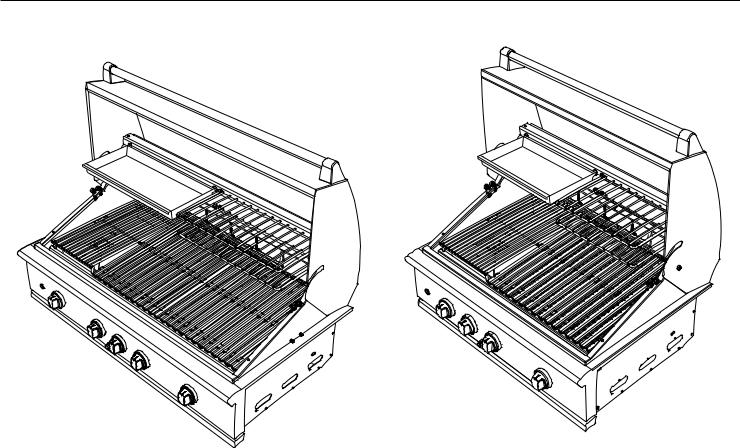
GRILL MODELS
BE1-48R |
BE1-36R |
6
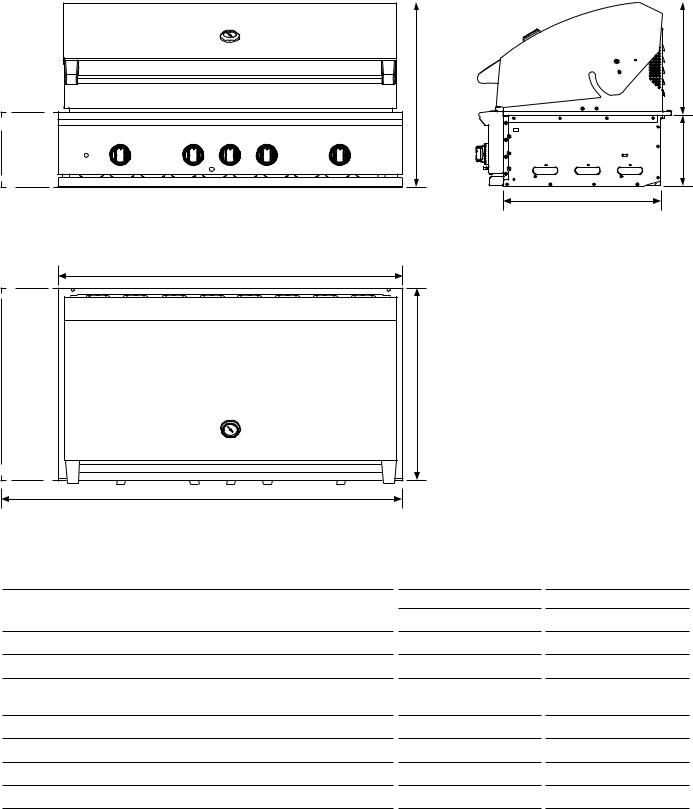
PRODUCT DIMENSIONS |
|
EN |
||
|
|
|
|
|
|
|
|
|
|
f
A
e
d
B
c
BE1-48R Model Illustrated
G
PRODUCT DIMENSIONS
A Overall height of grill
B Overall width of grill
COverall depth of grill (excluding handle and dials)
D Depth of chassis
E Height of chassis
f Height of hood
G Overall width of grill with storage unit attached
BE1-48R
Inches (mm)
27 1/4" (692)
47 15/16" (1217)
26 7/8" (682)
22" (559)
9 15/16" (252)
17 7/16" (443)
53 15/16" (1369)
BE1-36R
Inches (mm)
27 1/4" (692)
35 15/16" (912)
26 7/8" (682)
22" (559)
9 15/16" (252)
17 7/16" (443)
23 7/16" (1065)
7

INSTALLATION
Locating Grill/Built-in Clearances
IMPORTANT!
Before installation, remove shipping brackets from the grill. Loosen the four screws. Slide the shipping bracket off and re-tighten the screws.
Location
When determining a suitable location, take into account concerns such as exposure to wind, proximity to traffic paths and keeping any gas or electrical supply lines as short as possible and away from heat sources. Locate the grill only in a well ventilated area. Do not build the grill under overhead unprotected combustible construction. Never locate the grill in a building, garage, breezeway, shed or other such enclosed areas. During heavy use, the grill will produce a lot of heat and smoke. Ensure that the grill is used in a well ventilated area.
If locating the grill in a windy area, try to locate the grill so the prevailing wind will blow air at the front of the grill as shown in Fig. 01b. This will assist the grill in venting hot air through the back of the grill. In addition, this will help keep any smoke from blowing at someone who is cooking on the grill. If you have to locate the grill in a windy area where the prevailing wind is at the rear of the grill (Fig. 01a), a windscreen must be installed. The windscreen should be set-up so that it blocks wind from entering the exhaust vent in the rear of the unit as shown in Fig. 01c. Location of the windscreen relative to rear of the grill must adhere to the clearances specified for combustible or non-combustible construction as defined in these instructions. Refer to following pages.
As a high-performance gas appliance, your grill requires significant amounts of air to support the combustion process. Your grill is designed to take air in through the valve panel area, and send the exhaust products out through the exhaust gap at the rear of the hood. Using your grill in windy conditions can disrupt the proper flow of air though your grill, leading to reduced performance, or in certain severe cases, causing heat buildup in the valve panel area. This can lead to problems such as having the knobs melt, or burn hazards when the valve panel surfaces become too hot to touch.
Please note that damage to your grill resulting from use in windy conditions, such as melted knobs or igniter wires, or valve panel discoloration from heat build-up, are excluded from warranty coverage.
8

INSTALLATION |
EN |
|
|
Locating Built-in Clearances
IMPORTANT!
Gas fittings, regulator, and installer supplied shut-off valves must be easily accessible.
GRILL EXHAUST
EXHAUST |
|
EXHAUST |
|
WIND
DIRECTION
FLAME LIFT
PREFERRED
AIR FLOW
FIG. 01a |
FIG. 01b |
Wind hitting the grill while in use, (especially wind blowing into or across the hood gap) can cause poor performance and in some cases can cause the control panel to get dangerously hot.
EXHAUST VENT FLOW
WIND
PRIMARY INTAKE
AIR FLOW
WIND
FIG. 01c
WIND
15” (381 mm) min.
3” (76 mm) min. for non-combustibles
18” (457 mm) min. for combustibles
If wind is an issue, a windscreen should be added. The windscreen should be higher than the top of the opening in the back of the grill, with a minimum clearance of 3” (76mm) for non-combustibles, or 18” (457mm) for combustibles, from the back of the grill
9
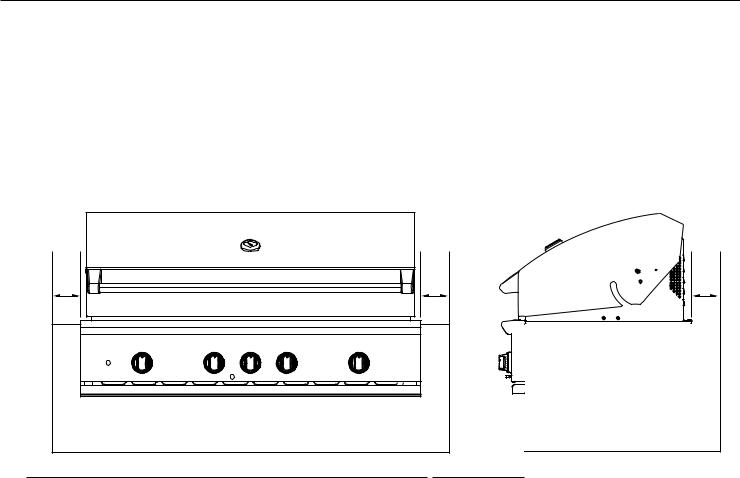
INSTALLATION
Locating Built-in Clearances
Clearances to non-combustible construction*
A minimum of 3” (76mm) clearance from the back of the grill to non-combustible construction is required for the purpose of allowing the hood to open fully. It is desirable to allow at least 6” (153mm) rear and side clearance to non-combustible construction above the cooking surface for
counter space. If you’ll be using the rotisserie option, the space is essential for motor and skewer clearance. The grill can be placed directly adjacent to non-combustible construction below the cooking surface (Fig. 02).
Note: if intending to use the rotisserie, the minimum clearance will be from the rotisserie motor instead of the side of the grill.
A |
A |
A |
FIG. 02
PRODUCT DIMENSIONS |
|
INCHES (MM) |
|
|
|
|
|
|
|
|
|
|
NON-COMBUSTIBLE |
A Minimum distance from non-combustible surface to grill |
3" (76) |
|
|
= |
||
|
|
SURFACE |
||||
|
|
|
|
|
|
|
*DEFINITION OF NON-COMBUSTIBLE MATERIAL - Material which is not capable of being ignited and burned, such as materials consisting entirely of, or a combination of, steel, iron, brick tile, concrete, slate, and plaster.
General
The grill is designed for easy placement into built-in masonry enclosures. For non-combustible applications the grill drops into the opening shown in Fig. 05 and hangs from its side flanges. A deck is not required to support it from the bottom. When using the insulated jacket in a combustible enclosure application, see the Fig. 06. The insulation jacket assembly must be supported from the bottom by a ledge on each side and back or a solid deck.
A spirit level should be used to ensure that the unit is level both front-to-back and side-to-side. If it is not level, burner combustion may be erratic or the unit may not function efficiently for grease flow. If the floor is uneven, re-leveling may be required whenever a freestanding unit is moved.
IMPORTANT!
yFailure to maintain required clearances creates a fire hazard that may result in property damage or serious personal injury.
yThe grill is designed to function in an open area. Recommended minimum clearances should be maintained to all surfaces (combustible and non-combustible) for optimum performance. Noncombustible material within the minimum clearance area could result in discoloration or deterioration.
yIf a non-combustible material such as stucco is covering a combustible material such as wood, the minimum clearance distance needs to be considered for wood. The presence of a non-combustible material inside the clearance zone does not eliminate the minimum clearance zone to combustible
material.
10
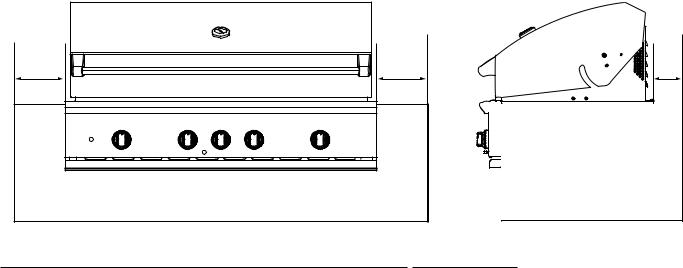
INSTALLATION |
EN |
|
|
Locating Built-in Clearances
Clearances to combustible construction**
Minimum of 18” (457mm) from the sides and rear of grill must be maintained to adjacent vertical combustible construction, above the counter top level. Intense heat, and large volumes of smoke will exhaust from the rear of the grill (Fig. 01b). This may discolor or damage unprotected areas. Do not install under unprotected combustible construction without using a fire safe ventilation system.
A 18” (457mm) minimum clearance must be maintained under the counter top to combustible construction. The clearance can be modified by a use of an insulated jacket. Insulated jackets can be purchased from our website, www.dcsappliances.com.
A |
A |
FIG. 03
A |
PRODUCT DIMENSIONS |
|
INCHES (MM) |
|
|
|
|
|
|
|
|
= SURFACECOMBUSTIBLE |
A Minimum distance from combustible surface to grill |
18" (457) |
|
|
||
|
|
|
|
|
|
**DEFINITION OF COMBUSTIBLE MATERIAL - Any materials of a building structure or decorative structure made of wood, compressed paper, plant fibers, vinyl/plastic or other materials that
are capable of transferring heat or being ignited and burned. Such material shall be considered combustible even though flame-proofed, fire-retardant treated or surface-painted, or plastered.
IMPORTANT!
It is required that a minimum of three 10x10" (645 x 645mm) of ventilation opening be provided for both the left and right sides, as well as the back of enclosure (Fig. 05), in order to safely dissipate unburned gas vapors in the event of a gas supply leak.
Insulated jacket
If the grill is to be placed into a combustible enclosure, an approved insulated jacket is necessary. Insulated jackets are available from your dealer. Use only the DCS insulated jacket which has specifically been designed and tested for this purpose. Review the detail drawing shown (Fig. 06) and take into account the provisions shown for gas line hook-up clearance in the right rear corner. It is required that ventilation holes are provided in the enclosure to eliminate the potential build-up of gas in the event of a gas leak. The supporting ledges or deck must be level and flat and strong enough to support the grill and insulated jacket. The counter should also be level.
IMPORTANT!
Installing this product into a combustible enclosure without an insulated jacket could result in fire, property damage and personal injury.
11

INSTALLATION
Locating Built-in Clearances
Clearances to protected combustible construction***
A minimum of 12" (305mm) clearance from the sides and rear of grill must be maintained to adjacent vertical protected combustible construction. Intense heat, and large volumes of smoke will exhaust from the rear of the grill. This may discolor or damage unprotected areas. The 12" (305mm) includes 4" (102mm) min. non-combustible material plus an additional 8" (203mm) min. clearance between the grill and the protected combustible construction. This can be achieved by brick or concrete (Fig. 04a) or a metal stud finished with non-combustible substrate (Fig. 04b).
A |
A |
B |
B |
FIG. 04a
A |
A |
B |
B |
FIG. 04b
A
B
A |
B |
|
|
|
|
|
= |
NON-COMBUSTIBLE |
|
PRODUCT DIMENSIONS |
|
INCHES (MM) |
|
|
SURFACE |
||
|
|
|
|
SURFACECOMBUSTIBLE |
|||
|
|
|
|
|
= |
||
A Minimum non-combustible surface width |
|
4" (102) |
|||||
|
|
|
|
||||
B Minimum distance from combustible surface to grill |
|
12" (305) |
|
|
= METAL STUD |
||
|
|
|
|
|
|
|
|
***DEFINITION OF PROTECTED COMBUSTIBLE SURFACE - A wall of non-combustible material in front a wall of combustible material, to act as a barrier. For definitions of non-combustible and combustible material, please refer to previous pages.
12
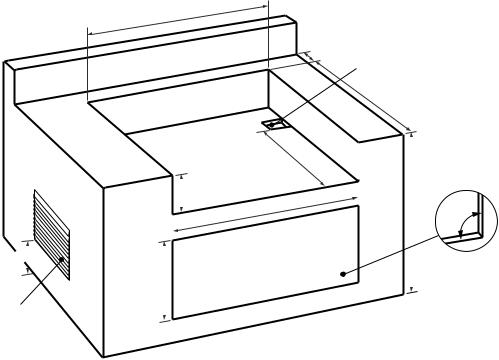
INSTALLATION |
EN |
|
|
Built-in Construction Details
Standard layout for non-combustible cavity
IMPORTANT!
If installing the grill into a non-combustible enclosure, all combustible construction must still be outside the 18" (457mm) clearance zone. If your island is made of stucco over the top of wooden studs, the wood can not be inside the 18 inch clearance zone to combustible, even though the stucco is what is touching the grill area.
D
C |
Note: 4x4” (102 x 102mm) |
|
opening for gas supply line |
B
|
|
|
|
|
|
|
|
F |
|
|
|
|
|
|
|
|
|
|
|
|
|
|
|
|
|
|
|
|
|
|
|
E |
|
|
|
|
|
|
|
G |
|
|
|
|
|
I |
|
|
A |
||
|
|
|
|
|
|
|
|
|||||
|
|
|
|
|
|
|
|
|
||||
|
|
|
|
|
|
|
|
|||||
|
|
|
|
|
|
|
|
|
|
|
||
|
|
|
|
|
|
|
|
|
|
|
||
|
|
|
|
|
|
|
|
|
|
|
|
|
|
|
|
|
|
|
|
|
|
|
|
|
|
|
|
|
H |
|
|
|
|
|
|
|
|
Note: the cut-out of each |
|
|
|
|
|
|
|
|
|
|
|
||
|
|
|
|
|
|
|
|
|
|
|
corner should be a 90°angle |
|
|
|
|
|
|
|
|
|
|
||||
|
|
|
|
|
|
|
|
|
|
|
|
in order for the access doors/ |
Note: vents are to be located at the left, |
|
|
|
|
|
|
|
|
drawers to fit properly. |
|||
|
|
|
|
|
|
|
|
|
||||
right and rear of the enclosure. Minimum |
|
|
|
|
|
|
||||||
size of all vents is 10x10" (645mm x 645mm) |
|
|
|
|
|
|
||||||
|
|
|
|
|
|
FIG. 05 |
|
|
|
|
|
|
|
|
|
|
|
|
|
|
|
|
|
|
|
|
CAVITY DIMENSIONS |
|
BE1-48R |
|
BE1-36R |
|||||||
|
|
|
|
|
|
|
||||||
|
|
Inches (mm) |
|
Inches (mm) |
||||||||
|
|
|
|
|
|
|
|
|
||||
|
|
|
|
|
|
|
|
|
|
|
|
|
|
A Maximum height of enclosure shell |
35 1/2" (902) |
35 1/2" (902) |
|||||||||
|
|
|
|
|
|
|
|
|
|
|
|
|
|
B Depth of enclosure shell |
22 3/4" (578) |
22 3/4" (578) |
|||||||||
|
|
|
|
|
|
|
|
|
|
|
|
|
|
C Minimum depth for hood swing |
3 3/4" (95) |
3 3/4" (95) |
|||||||||
|
|
|
|
|
|
|
|
|
|
|
|
|
|
D Width of enclosure cavity |
45 3/4" (1162) |
34 1/2" (876) |
|||||||||
|
|
|
|
|
|
|
|
|
|
|
|
|
|
E Height of enclosure cavity |
10 1/8" (257) |
10 1/8" (257) |
|||||||||
|
|
|
|
|
|
|
|
|
|
|
|
|
|
f Depth to gas supply opening |
18 1/2" (464) |
18 1/2" (464) |
|||||||||
|
|
|
|
|
|
|
|
|
|
|
|
|
|
G Height to base of vents |
1" (25) |
1" (25) |
|||||||||
|
|
|
|
|
|
|
|
|
|
|
|
|
|
H Height of opening for access doors/drawers |
20" (508) |
20" (508) |
|||||||||
|
|
|
|
|
|
|
|
|
|
|
|
|
|
I Width of opening for access doors/drawers |
46" (1168) |
34" (864) |
|||||||||
|
|
|
|
|
|
|
|
|
|
|
|
|
13
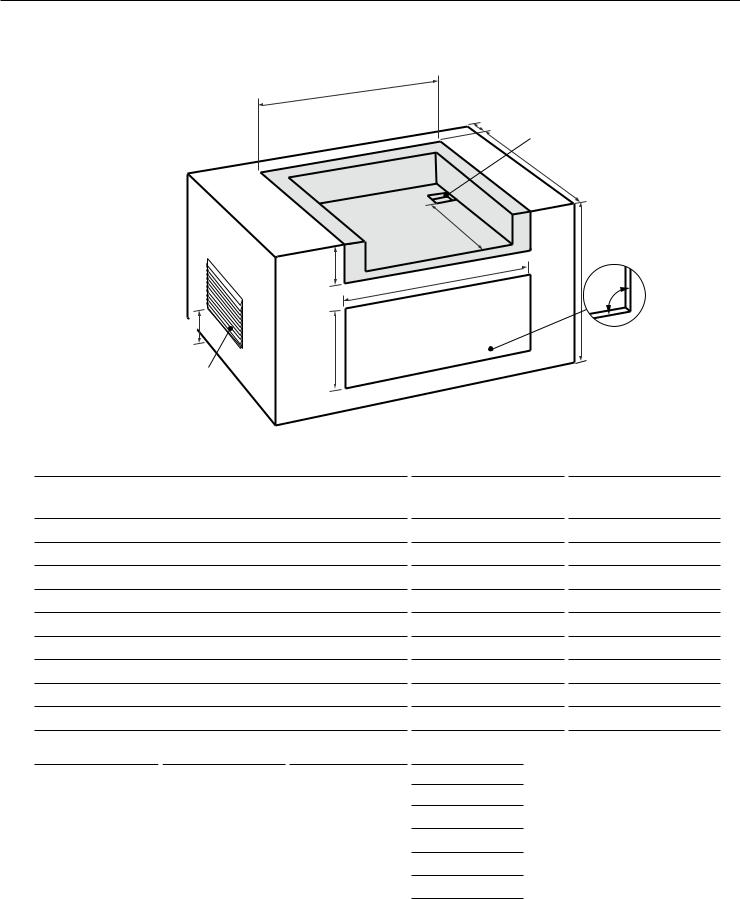
INSTALLATION
Built-in Construction Details
Standard layout for cavity including insulated jacket
D
E
G
H
Note: vents are to be located at the left, right and rear of the enclosure. Minimum size of all vents is 10x10" (645mm x 645mm)
FIG. 06
CAVITY DIMENSIONS
A Maximum height of enclosure shell
B Depth of enclosure shell
C Minimum depth for hood swing
D Width of enclosure cavity
E Height of enclosure cavity
f Depth to gas supply opening
G Height to base of vents
H Height of opening for access doors/drawers
I Width of opening for access doors/drawers
ACCESS DOORS |
|
ACCESS DRAWERS |
|
CAVITY WIDTH |
MODEL NUMBER |
|
MODEL NUMBER |
|
Inches (mm) |
|
|
|
|
|
|
|
|
|
|
ADN1-20x48 |
|
ADR2-48 |
46" (1168) |
|
|
|
|
|
|
ADN1-20x36 |
|
ADR2-36 |
34" (864) |
|
|
|
|
|
|
ADN1-20x30 |
|
ADR2-30 |
28" (711) |
|
|
|
|
|
|
ADN1-20x24 |
|
ADR2-24 |
22" (559) |
|
|
|
|
|
|
C |
Note: 4x4” (102mm x 102mm) |
|
opening for gas supply line |
||
|
B
F
I
A
Note: the cut-out of each corner should be a 90°angle in order for the access doors/ drawers to fit properly.
BE1-48R |
|
BE1-36R |
Inches (mm) |
|
Inches (mm) |
35 1/2" (902)
22 3/4" (578)
3 3/4" (95)
51 5/8" (1318)
11 1/8"(283)
18 1/2"(464)
1" (25)
20" (508)
46" (1168)
CAVITY HEIGHT
Inches (mm)
20" (508)
20" (508)
20" (508)
20" (508)
35 1/2" (902)
22 3/4" (578)
3 3/4" (95)
40 1/2" (1029)
11 1/8"(283)
18 1/2"(464)
1" (25)
20" (508)
34" (864)
To order access drawers or doors, please visit www.dcsappliances.com for further details.
14
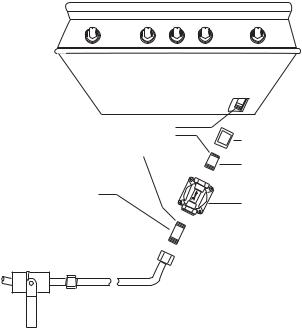
INSTALLATION |
EN |
|
|
Gas Hook-up
Gas requirements
Verify the type of gas supply to be used, either natural or LP, and make sure the marking on the appliance rating plate agrees with that of the supply. The rating plate is located on the underside of the drip tray. Never connect an unregulated gas line to the appliance. You must use a gas regulator even if the supply is controlled.
An installer-supplied gas shut-off valve must be installed in an easily accessible location. All installer supplied parts must conform to local codes, or in the absence of local codes, with the National Electrical Code, ANSI/NFPA 70 or the Canadian Electrical Code, CSA C22.1, and the National
Fuel Gas Code, ANSI Z223.1 or CSA-B149.1 Natural Gas Installation Code or CSA-B149.2 Propane Installation Code.
All pipe sealants must be an approved type and resistant to the actions of LP gases. Never use pipe sealant on flare fittings. All gas connections should be made by a qualified technician and in accordance with local codes and ordinances. In the absence of local codes, the installation must comply with the National Fuel Gas Code ANSI Z223.1. Gas conversion kits are available from Customer care. When ordering gas conversion kits, have the model number, and the type of gas (natural or LP) from your grill.
Total gas consumption of the grill with all burners on HI
BE1-48R - 118,000 Btu/hr or 124.5 Mj/hr BE1-36R - 89,000 Btu/hr or 93.3 Mj/hr
The appliance and its individual shut-off valve must be disconnected from the gas supply piping system during any pressure testing of that system at test pressures in excess of 1/2 PSIG (3.5 kPa). The appliance must be isolated from the gas supply piping system by closing its individual manual shut-off valve during any pressure testing of the gas supply piping system at test pressures equal to or less than 1/2 PSIG (3.5 kPa). The installation of this appliance must conform with local codes or, in the absence of local codes, with the National Fuel Gas Code, ANSI Z223.1/NFPA 54. Installation in Canada must be in accordance with Natural Gas and Propane Installation Code, CSA B149.1, and/or Propane Storage and Handling Code, B149.2 and local codes.
Natural gas built-in hook-up
(This should be performed by a technician only.) Connection: 1/2” NPT female. Operating pressure:
4.0” W.C. Supply pressure: 5” to 14” WC. If in excess of 14” W.C. a step down regulator is required. Check with your local gas utility company or local codes for instructions on installing gas supply lines. Be sure to check on type and size of run, and how deep to bury the line. If the gas line is too small, the grill will not function properly. Any joint sealant used must be an approved type and be resistive to the actions of LP gases.
To hook-up the fittings supplied with the grill
Assemble as shown (Fig. 07). Use threading compound on male threads only. Use a second pipe wrench to hold the grill inlet pipe to avoid shifting any internal gas lines of the grill. Ensure that the regulator arrow points in the direction of gas flow towards the unit, away from the supply. Do not forget to place the installer-supplied gas valve in an accessible location.
Bottom of unit
Threading compounds
(Must be resistant to Coupling LP gas)
|
1/2” NPT |
|
x 2.0” |
1/2” NPT x |
NIpple |
5.0" Nipple |
Regulator |
|
|
|
4.0" W.C. |
Installer supplied shut-off valve must be easily accessible*
*Installation must conform with local codes or with the National Fuel Gas Code ANSI Z223.1 or the CSA-B149.2 Propane Installation Code
FIG. 07 Natural Gas
15

INSTALLATION
Gas Hook-up
LP cart hook-up
Grills orificed for use with LP gas come equipped with a high capacity hose/regulator assembly for connection to a standard 20 lb. LP cylinder (Type 1). The LP tank is not included. The grill system is leak tested, do not remove the Regulator/Hose assembly from the grill during cart installation.
Connection: LP Hose with a Type 1 quick disconnect and regulator is included. Operating pressure: 11.0” W.C. Note: all gas piping and connectors must conform to the Standard for Connectors for Outdoor Gas Appliances and Manufactured Homes, ANSI Z21.75/CSA 6.27.
To connect the LP regulator/hose assembly to the tank/valve assembly, first make sure the main valve on the tank is completely closed. Although the flow of gas is stopped when the Type 1 system is disconnected as part of its safety feature, you should always turn off the LP tank main valve (Fig. 08) after each use and during transport of the tank or unit. Insert the regulator inlet into the tank valve and turn to the black coupler clockwise until the coupler tightens up. Do not over tighten
the coupler. Turn the main tank valve on and turn the burner control valves on the unit to the “HI” position for about 20 seconds to allow the air in the system to purge. Turn valves off and wait five minutes before attempting to ignite the burners.
To disconnect the coupler, first make sure the main tank valve is turned off. Grasp the coupler and turn counter clockwise. The inlet will then disengage. Remove the inlet from the tank valve opening if it has not already done so when it disengaged. Your local LP filling station should be equipped with the proper equipment to fill your tank.
Type 1 Regulator
Main Tank Valve 
20 lb. LP Tank
Bottom of unit
Elbow 45° 1/2” female
NPT x 3/8” male flare (installed on the unit)
LP Regulator hose assembly 11" W.C.
*Installation must conform with local codes or with the National Fuel Gas Code ANSI Z223.1 or the CSA-B149.2 Propane Installation Code
IMPORTANT!
yBefore connecting LP tank to regulator, check that all grill burners and rotisserie valves are in the OFF position and open grill hood.
yDo not place the Grill directly on the ground or any other flat surface without support. This will prevent damaging the regulator/hose assembly by the weight of the grill.
yCheck the hose, regulator and connectors for damage. Look for cracks, abrasions, brittleness, holes, dents and nicks.
yDo not attempt to remove, repair, or replace the regulator/hose assembly by yourself. It must be done by a qualified licensed technician only.
FIG. 08 LP Gas - Cart
LP tank requirements:
A dented or rusty LP tank may be hazardous and should be checked by your LP supplier. The cylinder that is used must have a collar to protect the cylinder valve. Never use a cylinder with a damaged valve. Always check for leaks after every LP tank change. The LP gas cylinder must
be constructed and marked in accordance with the specifications for LP gas cylinders of the U.S. Department of Transportation (DOT or CAN/CSA-B339) and designed for use with a Type 1 system only. Do not change the regulator/hose assembly from that supplied with the unit or attempt to use a Type 1 equipped regulator/hose assembly with a standard 510 POL tank/valve assembly. The
cylinder must be provided with a shut-off valve terminating in an LP gas supply cylinder valve outlet specified, as applicable, for connection Type 1. If the appliance is stored indoors, the cylinder must be disconnected and removed from the appliance. Cylinders must be stored outdoors in a wellventilated area out of the reach of children.
16

INSTALLATION |
EN |
|
|
Gas Hook-up
LP built-in hook-up
If the grill is to be installed in a built-in application, then the grill must be installed in accordance with the built–in installation guidelines and the LP regulator/hose assembly must be removed from the product.
Connection: LP Hose with a Type 1 quick disconnect and regulator is included. Operating pressure: 11.0” W.C. All gas piping and connectors must conform to the Standard for Connectors for Outdoor Gas Appliances and Manufactured Homes, ANSI Z21.75/CSA 6.27.
If you intend to operate your built-in grill on LP gas utilizing a 20v lb type 1 cylinder, then a builtin LP tank restraint must be installed prior to initial use of the grill. The Installer must supply ½” ID Flex hose and fixed pipe and a flare adaptor as indicated in Fig. 09.
Adapter 3/8” flare fitting
1/2” NPT female (not supplied)
LP regulator/ hose assembly
20 lb LP Tank
(not supplied)
Tank retention device (not supplied)
Bottom of unit
1/2” ID flex hose with 1/2” NPT fittings (not supplied)
1/2” NPT fixed pipe (not supplied)
Enclosure wall
FIG. 09 LP Gas - Built-in
Note: when an LP unit is being directly connected to an LP house system, you must follow the natural gas hook up guidelines.
The installer must provide the proper gas regulator to reduce the gas pressure to 11” W.C.
IMPORTANT!
Gas piping and connectors must be clamped within the the enclosure to avoid contact with moving parts and hot surfaces. Where the gas piping passes through an opening in the enclosure, the piping must be protected for a distance of at least 2” (50mm) either side of the opening.
17
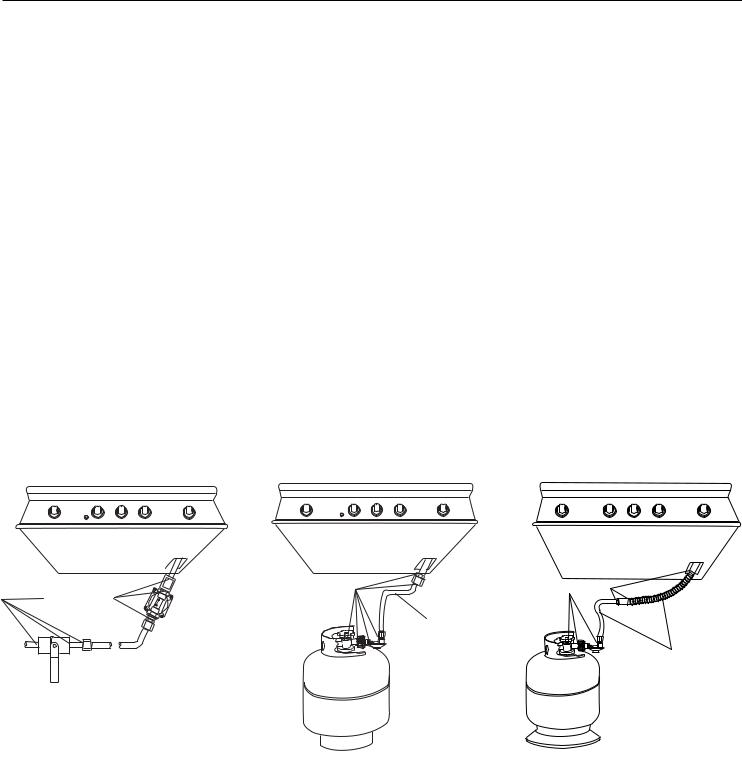
INSTALLATION
Leak Testing
IMPORTANT!
Gas leak testing must be carried out by a qualified technician.
General
Regularly check the whole system for leaks, or immediately check if the smell of gas is detected.
Before Testing
Do not smoke while leak testing. Extinguish all open flames. Never leak test with an open flame.
Make a soap solution of one part liquid detergent and one part water. You will need a spray bottle, brush, or rag to apply the solution to the fittings. For LP units, check with a full cylinder.
To Test
Make sure all control valves are in the “OFF” position. Turn the gas supply “ON”. Check all connections from the supply line, or LP cylinder. Apply the soap solution around the connection, tubing and end of the manifold. Soap bubbles will appear where a leak is present. If a leak is present, immediately turn off gas supply, tighten any leaking connections, turn gas on, and recheck.
If you cannot stop a gas leak turn off the gas supply and call your local gas utility, or the dealer you purchased the appliance from. Only those parts recommended by the manufacturer should be used on the grill. Substitution can void the warranty.
IMPORTANT!
yDo not use the grill until all connections have been checked and do not leak.
yCheck all gas supply fittings for leaks before each use. Keep a spray bottle of soapy water near the gas supply shut-off valve. Spray all the fittings, bubbles indicate leaks
BOTTOM OF UNIT |
BOTTOM OF UNIT |
BOTTOM OF UNIT |
|
||
|
LEAK TEST POINTS |
LEAK TEST POINTS |
|
|
LEAK TEST POINTS
CHECK HOSES
FOR SIGNS OF
CRACKS, LEAKS
OR ABRASIONS
CHECK HOSES
FOR SIGNS OF
CRACKS, LEAKS
OR ABRASIONS
FIG. 10 Nat. Gas |
FIG. 11 LP Gas - cart |
FIG. 12 LP Gas - built-in |
18
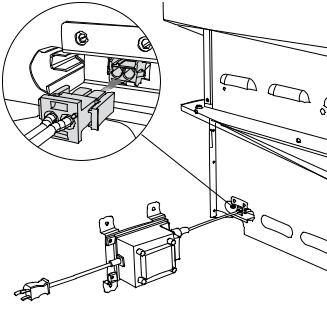
INSTALLATION |
EN |
|
|
Electrical Connection
IMPORTANT!
Use only a Ground Fault Interrupter (GFI) protected circuit with this grill.
General
Connection to AC Installation requires an outdoor 120VAC 15A GFI (Ground Fault Interrupter) electrical outlet adjacent to the grill. The GFI outlet features an internal breaker that reduces shock hazard. This type of outlet should be installed by a qualified electrician either inside the island enclosure for built-in units, or near the location where a free-standing unit will be used. For built-in grills, the supplied 12V transformer is connected to the grill during installation.
All grill models have a power transformer for the ignition and internal lighting, which is concealed in a box with an attached power supply cord. This transformer must be secured in a dry location and away from the grill firebox and excessive heat area. When installing, it is recommended that the transformer be located below the grill in a readily accessible location. Be sure to provide adequate access to facilitate service if the transformer or connections should need future maintenance.
If the electrical system fails to operate, a connection may have come loose in shipping or the GFI may have tripped, requiring a reset. See the Troubleshooting section for more details.
IMPORTANT!
To protect against electrical shock, do not immerse any power cords or plugs in water or any other liquid.
FIG. 13 Transformer Install Location
19
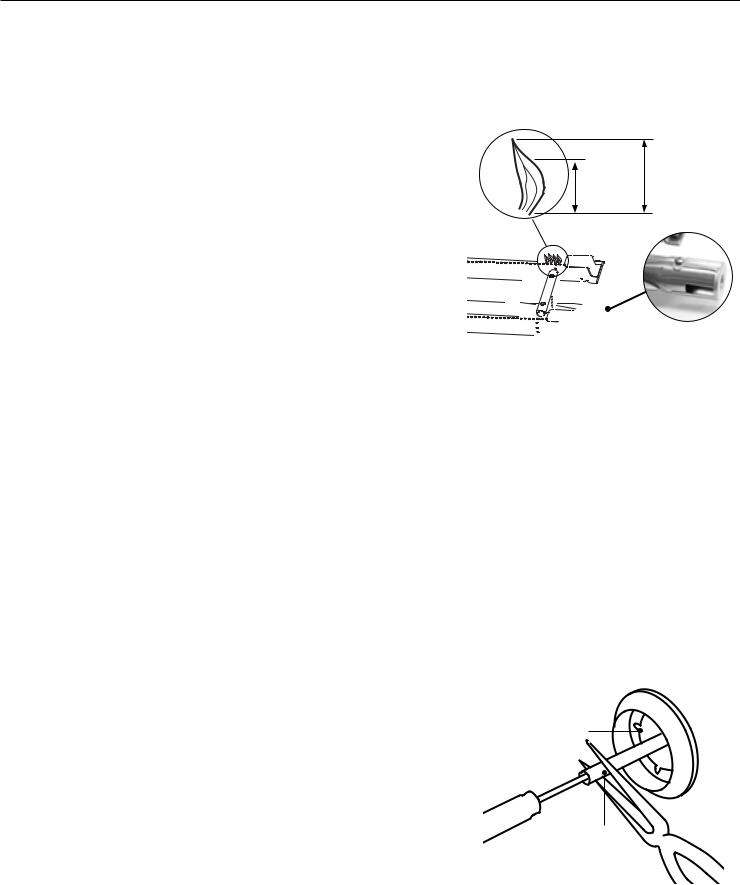
INSTALLATION
Burner Adjustment
IMPORTANT!
Before lighting, inspect the gas supply piping or hose prior to turning the gas “on”. If there is evidence of cuts, wear, or abrasion, it must be replaced prior to use.
Grill burner air adjustment |
|
Each grill burner is tested and adjusted at the factory prior |
|
to shipment; however, variations in the local gas supply or a |
|
conversion from one gas to another may make it necessary |
⅜" |
to adjust the burners. The flames of the burners (except the |
|
rotisserie burner) should be visually checked and compared |
(10mm) |
|
|
to that of the drawing in Fig.14. Flames should be blue and |
|
stable with no yellow tips (LP units may have some yellow |
|
tipping), excessive noise or lifting. If any of these conditions |
|
exist, check if the air shutter or burner ports are blocked by |
|
dirt, debris, spider webs, etc. If cleaning the burner ports |
|
and air shutter does not improve performance, you can alter |
|
the air shutter adjustment. The amount of air which enters a |
|
burner is governed by a metal cup at the inlet of the burner |
|
called an air shutter. It is locked in place by a screw which |
|
must be loosened prior to lighting the burner for adjustment. |
FIG. 14 |
|
1 ½"
(38mm)
Grill burner flame height
Before beginning, ensure the grill is OFF and cool. To access the grill burner air shutters, first remove the grates and radiants from the firebox, then remove the grill burner using instructions shown on page 41. With a screw driver, loosen the lock screw on the face of the air shutter slightly so that the air shutter can be adjusted.
To adjust
1 Be careful as the burner may be very hot.
2If the flame is yellow, indicating insufficient air, turn the air shutter counter-clockwise to allow more air to the burner.
3If the flame is noisy and tends to lift away from the burner, indicating too much air, turn the air shutter clockwise.
Note: reinstall the U-burner, ensuring the burner is level. Light the burner and check the flame. If the color of the flame is blue and the height is stable, remove the burner and tighten the air shutter screw. If the flames show instability or an inconsistent color, repeat the above procedure to readjust the air shutter.
Low flame setting adjustment
The valves on the grill feature an adjustable low setting. Due to fluctuations in gas pressure, heating value or gas conversion, you may feel it necessary to increase or decrease gas flow in the low position. We do not recommend adjusting the infrared rotisserie burner.
To adjust
1 Light the burner.
2 Turn the control knob to the lowest setting (counter-clockwise). 3 Remove the knob.
4While holding the valve shaft with pliers, insert a thin, flat tipped screwdriver into the shaft and while viewing the burner adjust to a minimum stable flame.
BEZEL
VALVE STEM
FIG. 15
20
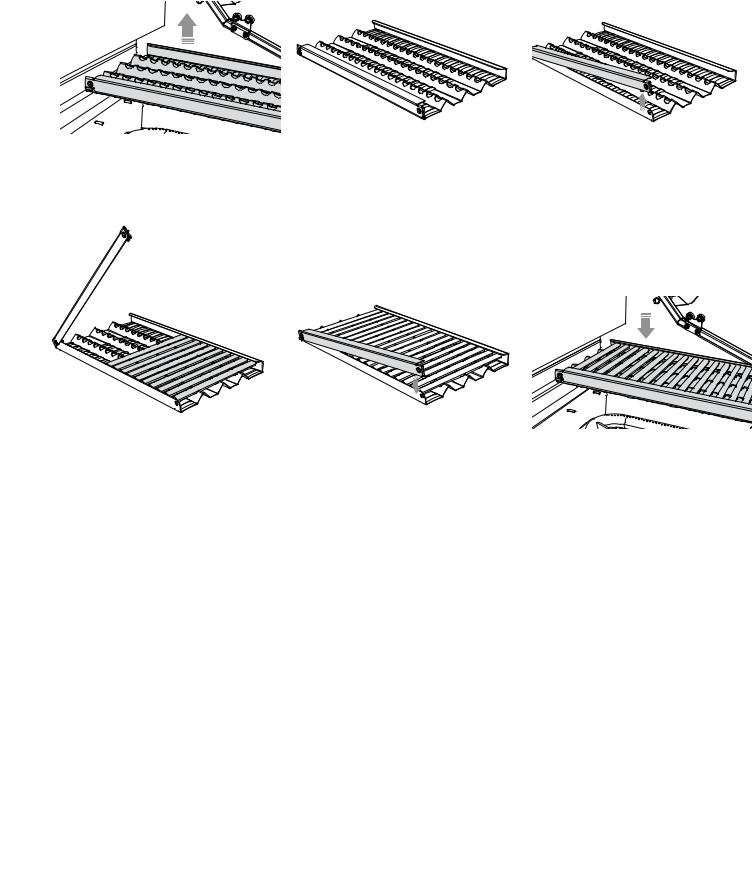
INSTALLATION |
EN |
|
|
Radiant Assembly
IMPORTANT!
Before assembling the radiant, check that the radiant trays have not moved during transit. They should sit securely on their locating pins in the base of the grill.
1 Locate the radiant in the unit.
4Place the 18 ceramic rods onto the radiant.
2Unpack ceramic rods and remove radiant from the unit.
5 Lock radiant end cap.
If a ceramic rod breaks
1 Unlock radiant end cap by pushing it up with two fingers. 2 Replace broken ceramic rod.
3 Lock radiant end cap.
3Unlock radiant end cap by pushing it up with two fingers.
6Place the assembled radiant into the unit.
To order a replacement ceramic rod, please visit www.dcsappliances.com
21
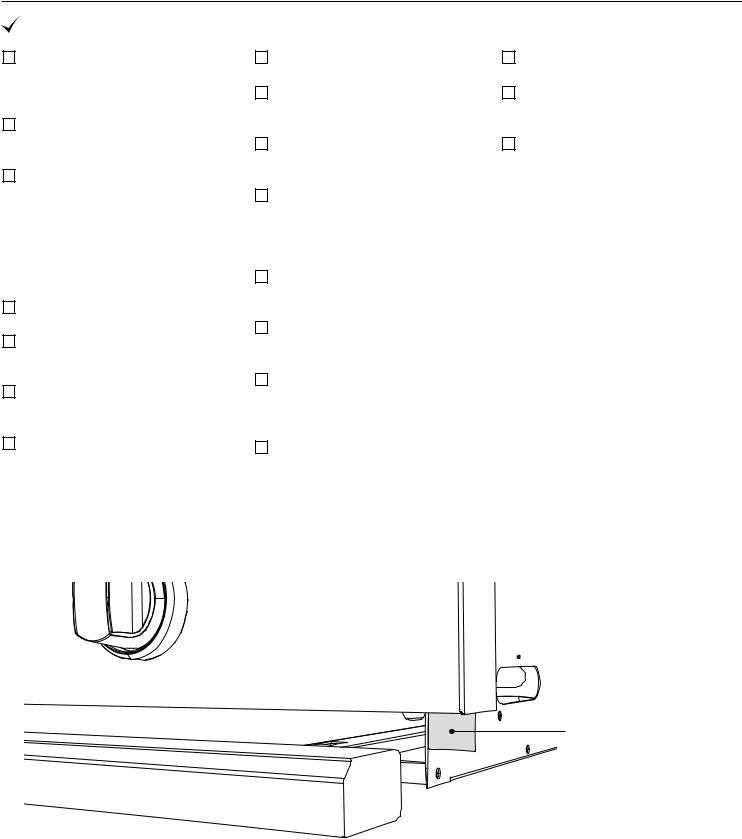
INSTALLATION
Installer Checklist
Specified clearances maintained to combustibles
Verified proper enclosure ventilation
All internal packaging and any adhesive residue removed. To remove stubborn residue, use rubbing alcohol or a commercially available adhesive remover
Removed shipping bracket
Knobs turn freely, bezels centered
Halo lighting is functioning correctly
Each burner lights satisfactorily - individually or with adjacent burner lit
Air shutters adjusted
Low flame setting satisfactory
Drip pan in place properly and sliding freely
Pressure regulator connected and set for 4.0” C.E. Natural, 11.0” C.E. LP gas
Manual shut-off valve installed and accessible
Unit tested and free of leaks
User informed of gas supply shut-off valve location
All radiant trays are assembled and put in place
Check match lighting
Internal lighting is functioning correctly
Transformer is tidy and mounted securely, in a suitable location
Please leave these instructions with the user.
User, please retain these instructions for future reference.
Contact DCS at www.dcsappliances.com if any of the listed items are missing. Please be prepared with your Model #, Serial # and description of item(s) that are missing.
Tag location of
Model # and Serial #
IMPORTANT!
Read all installation instructions in this manual to see if the unit has been correctly installed. Ensure that installation has been completed correctly before use.
22
EN
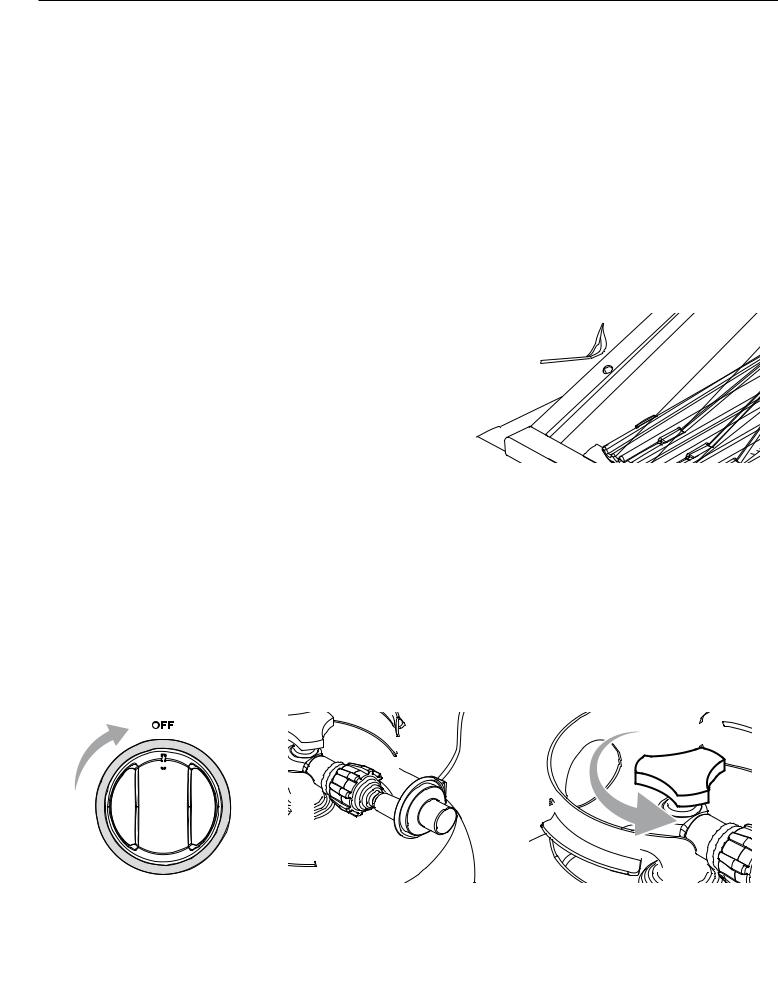
USING THE GRILL
Lighting Instructions
Grill lighting instructions
IMPORTANT!
Open the grill hood before lighting. Turn all knobs to “OFF”. Turn the main gas supply on. If you smell gas, shut-off gas supply and call for customer care.
Pushing in on the burner knob will activate the Grill Igniter, and then turning the knob from the “OFF” position will allow the flow of gas to the burner.
The Grill Igniter will glow orange, but there will be no clicking sound during ignition. Push in and hold the selected burner knob for two seconds. Verify that the hot surface igniter is glowing. Turn the burner knob to "SEAR" position. Release the knob when the burner lights. If burner does not light in four to five seconds, turn knob "OFF" and wait five minutes before trying again so any accumulated gas may dissipate.
IMPORTANT!
Only light one burner at a time.
Grill match lighting |
|
|
If the burner will not light after several attempts, then |
|
|
the burner can be match lit. If you have attempted to |
|
|
light the burner with the ignition, allow five minutes for |
|
|
any accumulated gas to dissipate. Keep your face as far |
|
|
away from the outdoor appliance as possible and hold |
|
|
a paper book match over the hole located on the top |
|
|
left for burner on the left, or the right hole for the right |
|
|
burner (Fig. 16). Push and turn the control knob which |
|
|
is centered on the burner where the lit match is located, |
|
|
to “SEAR”. If the burner does not light in four to five |
FIG. 16 |
|
seconds, turn knob off, wait five minutes and try again. |
||
|
Improper lighting procedures can cause the LP tank flow control to activate resulting in reduced heat output. If this is suspected the flow control will need to be reset.
See the Quick Start Guide for how to use the griddle and Infrared Hybrid Burner.
Refer to the Troubleshooting section of the user guide if you encounter any difficulties lighting your grill.
Resetting the flow control
IMPORTANT!
Failure to follow the steps in the order shown may cause the Flow Limiting Device to activate resulting in extremely low gas flow and irregular operation
|
|
|
|
|
|
|
|
|
|
|
|
|
|
|
|
|
|
|
|
|
|
|
|
|
|
|
|
|
|
|
|
|
|
|
|
|
|
|
|
|
|
|
|
|
|
|
|
|
|
|
|
|
|
|
|
|
|
|
|
|
|
|
|
|
|
|
|
|
|
|
|
|
|
|
|
|
|
|
|
|
|
|
|
|
|
|
|
|
|
|
|
|
|
|
|
|
|
|
|
|
|
|
|
|
|
|
|
|
|
|
|
|
|
|
|
|
|
|
|
|
|
|
|
|
|
|
|
|
|
|
|
|
|
|
|
|
|
|
|
|
|
|
|
|
|
|
|
|
|
|
|
|
|
|
|
|
|
|
|
|
|
|
|
|
|
|
|
|
|
|
|
|
|
|
|
|
|
|
|
|
|
|
|
|
|
|
|
|
|
|
|
|
|
|
|
|
|
|
|
|
|
|
|
|
|
|
|
|
|
|
|
|
|
|
|
|
|
|
|
|
|
|
|
|
|
|
|
|
|
|
|
|
|
|
|
|
|
|
|
|
|
|
|
|
|
|
|
|
|
|
|
|
|
|
|
|
|
|
|
|
|
|
|
|
|
|
|
|
|
|
|
|
|
|
|
|
|
|
|
|
|
|
|
|
|
|
|
|
|
|
|
|
|
|
|
|
|
|
|
|
|
|
|
|
|
|
|
|
|
|
|
|
|
|
|
|
|
|
|
|
|
|
|
|
|
|
|
|
|
|
|
|
|
|
|
|
|
|
|
|
|
|
|
|
|
|
|
|
|
|
|
|
|
|
|
|
|
|
|
|
|
|
|
|
|
|
|
|
|
|
|
|
|
|
|
|
|
|
|
|
|
|
|
|
|
|
|
|
|
|
|
|
|
|
|
|
|
|
|
|
|
|
|
|
|
|
|
|
|
|
|
|
|
|
|
|
|
|
|
|
|
|
|
|
|
|
|
|
|
|
|
|
|
|
|
|
|
|
|
|
|
|
|
|
|
|
|
|
|
|
|
|
|
|
|
|
|
|
|
|
|
|
|
|
|
|
|
|
|
|
|
|
|
|
|
|
|
|
|
|
|
|
|
|
|
|
|
|
|
|
|
|
|
|
|
|
|
|
|
|
|
|
|
|
|
|
|
|
|
|
|
|
|
|
|
|
|
|
|
|
|
|
|
|
|
|
|
|
|
|
|
|
|
|
|
|
|
|
|
1 All knobs must be in the |
2 Attach regulator hose |
3 Open the LP tank valve. |
|||||||||||||||||||||||||||
OFF position. |
|
|
|
|
assembly to the tank. |
|
|
|
|
(Two full turns min). |
|||||||||||||||||||
24
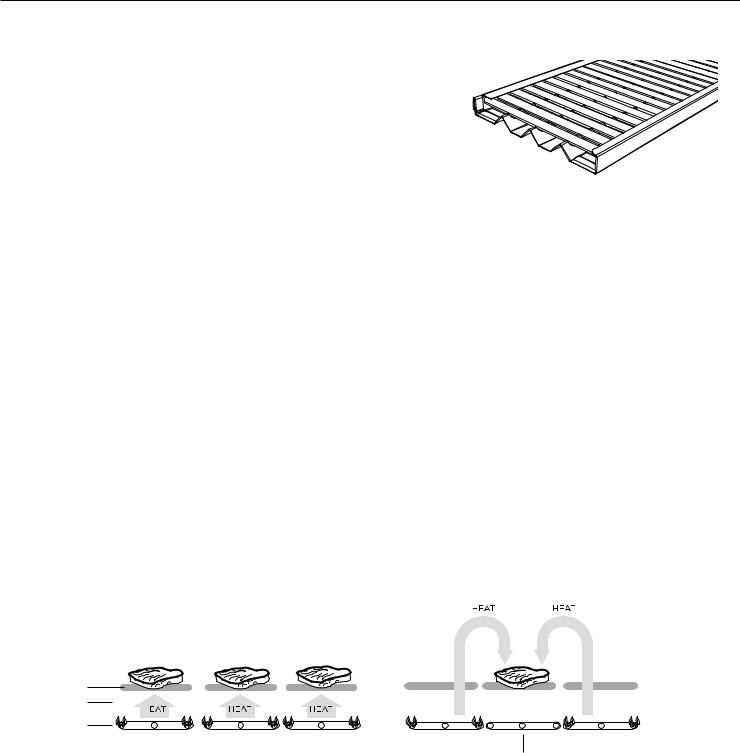
USING THE GRILL |
EN |
Grilling |
|
Grill |
|
Each grill section consists of a large stainless steel burner, |
|
stainless steel heat baffles, a series of ceramic rods encased |
|
in a stainless steel radiant, and a stainless steel heat retaining |
|
grate. Each burner is rated at 25,000 Btu/hr or 26,5MJ/h. |
|
Below the burners there is a stainless steel heat baffle which |
|
reflects usable heat upward into the cooking area and reduces |
|
temperatures of the drip pan below. Above the burners are |
|
stainless steel radiants which encase the ceramic rods and |
|
protect the grill burner ports from blockage (Fig. 17). |
FIG. 17 |
|
The grill is supplied with radiant ceramic rods. Because of the porosity of ceramic rods, performance is superior in the rods’ ability to capture heat as it rises from the grill burners. They also possess the thermal mass needed for even cooking performance. Flare ups are controlled because the radiant ceramic rods keeps grease from getting to the flames and igniting. The intense heat produced by this system produces true grilled flavor as fats and juices are brought to the surface of the food and caramelized. Discoloration of the grates is normal after use.
Direct/indirect cooking notes
Direct cooking involves placing food on grates over lighted burners. Use this method for foods that take less than 20 minutes to cook or to sear larger items at the start of the cooking process that will then be indirectly cooked to finish. Place items on the preheated surface and leave until they no longer stick. Never spray water on the grill or into grease. The patented Grease Management System™ reduces flare-ups by channeling grease away from the flame. Use a meat thermometer to achieve desired doneness and remove items one degree below how you would like to enjoy them, as the resting period before carving or consuming will raise the temperature.
Indirect cooking method is a popular alternative to direct heat grilling. Indirect cooking uses heat from an adjacent heat source to cook food and, in many cases, reduces the possibility of overcooked or overly browned food. Foods most appropriate for indirect grilling included breads, thicker pieces of chicken or steaks. Indirect cooking involves placing the food to the side of or above the heat source instead of directly over the flame and then closing the grill top to create an oven effect. All the items you usually oven-roast can be grilled to perfection using indirect heating. Preheat the burners surrounding the food to be cooked. Use your secondary cooking tray to hold food and add water or chicken broth to the tray to prevent the natural juices from burning or evaporating.
Direct Heat Grilling |
Indirect Heat Grilling |
FOOD
GRILL RACK
BURNER
BURNER OFF
IMPORTANT!
ySeason your grates before first use and then periodically to protect the grate surface from corrosion, and to stop food sticking. See 'Care and Maintenance'. To season the grates, pour a tablespoon of vegetable oil on a soft cloth and rub on both sides of the grates. Only a light coating is needed and some smoke may be visible during the preheating.
yGrilling requires high heat for searing and proper browning. Most foods are cooked at the “MEDIUM” to “LOW” heat setting for the entire cooking time. However, when grilling large pieces of meat or poultry, it may be necessary to turn the heat to a lower setting after the initial browning. This cooks the food through without burning the outside. Foods cooked for a long time or basted with a sugary marinade may need a lower heat setting near the end of the cooking time.
25

USING THE GRILL
Grilling
Secondary cooking
Two racks and one tray have been provided for secondary cooking. These can be utilized for warming, smoking, roasting or slow-cooking food. Before using the secondary cooking surfaces with the grill hood down, ensure that the height and width of food or cooking pans is not excessive. When closing the hood there is a chance that food or cooking pans may be dislodged if these items are too big. 20lbs is the maximum weight of food that should be placed in the secondary cooking area.
The secondary cooking racks and tray can be placed in four possible positions. When inserting the racks and trays above the grill, they will click into place.
Note: all trays and racks are dishwasher safe.
IMPORTANT!
Do not use the rotisserie burner when the secondary cooking racks or trays are in place. Before using the rotisserie burner, ensure that these racks and trays are removed.
SECONDARY COOKING TRAY |
SECONDARY COOKING RACKS |
WIRE GRATE
FIG. 18
Internal lighting
To add to the convenience of your grilling experience, the grill has internal lighting set inside the grill hood. This helps to help illuminate the cooking surface in low light. To turn on the lighting, push the LIGHT button on the lefthand side on the control panel. To turn it off, press the button again. For guidance on how to replace the light bulbs, please see the care and maintenance section. Replacement light bulbs are not covered by warranty.
Halo lighting
As an added feature, the grill is fitted with halo lighting. When the grill is switched on, the halo will turn white (Fig. 19), when a knob is turned away from the ‘OFF’ position, the halo will turn orange (Fig. 20).
DUAL-SIDED GRATES
|
|
|
|
|
|
|
|
|
|
|
|
|
|
|
|
|
|
|
|
|
|
|
|
|
|
|
|
|
|
|
|
|
|
|
|
|
|
|
|
|
|
|
|
|
|
|
|
|
|
|
|
|
|
|
|
|
|
|
|
|
|
|
|
|
|
|
FIG. 19 White Halo |
FIG. 20 Orange Halo |
||||||||
26
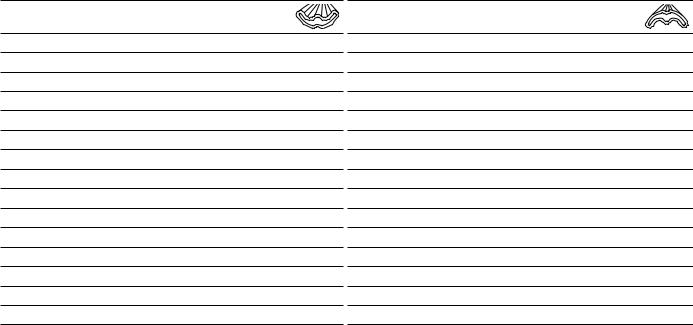
|
USING THE GRILL |
EN |
|
|
|
|
Grilling |
|
1 |
Ensure that the drip pan and grease tray are in place. |
|
2 |
Light the grill burners following the lighting instructions. |
|
3 |
Once you have verified the burners are lit, put the hood down to preheat for five to 10 minutes. |
|
4Place the food on the grill and cook to the desired doneness. Adjust heat setting, if necessary. The control knob may be set to any position between “SEAR” and “LOW"
5 When you have finished using the grill, turn the control knobs to “OFF” and shut off the main gas supply.
6Allow the grill to cool and clean the grates, drip pan and grease tray after each use.
Note: if using LP gas, your preheat time may be shorter than recommended. To prevent overcooking or burning, you may want to lower the heat settings.
Using the temperature gauge
When preheating the grill, use the temperature gauge in the hood to check if the grill has reached the desired heat setting.
Note: the temperature gauge only indicates air temperature inside the grill. For food safety and optimal cooking performance, use a meat probe to check the temperature of meat while cooking and to ensure desired internal temperatures are reached.
Wire grate
Designed to be used in conjunction with the charcoal insert, the wire grate fits on top of the insert to provide the perfect surface for smoking your food. Smoke meat straight on the grate for an intense flavour or use the grate to hold a tray of water under the meat to help even out the temperature and keep the meat moist. If you do not wish to use the charcoal insert, the wire grate is still excellent for normal grilling.
Note: the grate can only be used in a flat position (see page 32).
Dual-sided grates
Whether you or your guests crave seafood, steak or veggies, the double-sided grates provide varying surfaces for varying textures. The “W”-shaped side creates nice sear lines for steaks, chicken and chops and routes oil and grease away from the food. The opposite “radius” side offers more surface area for support and handling of delicate items like scallops. (See below for a sample list of which foods to cook on which side of the grate.)
"W" SHAPED GRATE
yChicken (bone-in and boneless cuts)
ySteaks
yChops
yBurgers
yRibs
yKabobs
ySteak cuts of fish like tuna and swordfish
yWhole fish
yGame
yOysters
yLarge slices of whole vegetables
yFruit
yBread
ySausages
yHot dogs
RADIUS GRATE
yDelicate fish fillets
yLobster meat
yShrimp
yScallops
yClams
yMussels
ySuckling pig
yTurkey legs
yIndirect cooking and smoking
yPotatoes
ySmaller vegetables or slices
yRoasted peppers
yRoasted whole garlic
yPizza dough and flat breads
yCrab cakes
27
